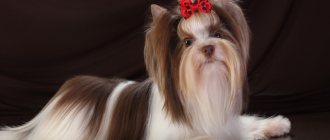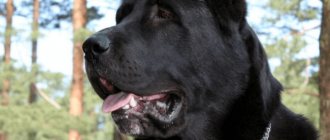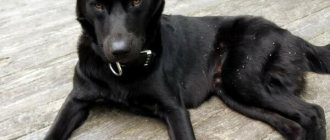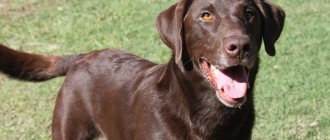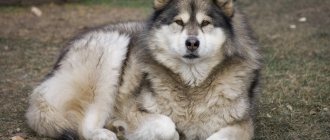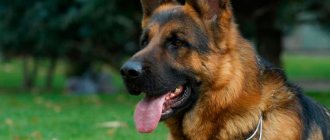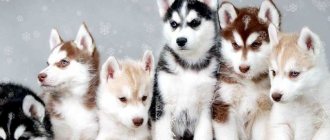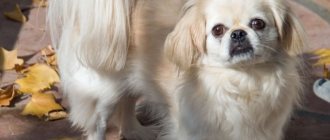The Toy Terrier is a decorative dog that has won the hearts of city residents.
Today, increasingly at social events, famous personalities appear in the company of these funny creatures.
Toy terriers are regaining the glory of salon dogs that originally belonged to them since the 18th century, when they were regulars in the living rooms of aristocrats.
The custom of keeping charming little ones in the house came to Russia along with the fashion for everything English.
The breed was bred in England for purely pragmatic purposes for hunting rats.
The attractive appearance and miniature size of terrier dogs appealed to noble people, and the dogs gradually turned into decorative ones.
Standard colors
Smooth-haired Toy Terriers come in all different shades. However, such standards were approved relatively recently. Even before the middle of the last century, representatives of this breed had one common shade of coat: breeders recognized the Toy Terrier as exclusively black and tan.
Nevertheless, already in the 70s of the 20th century, brown and tan, as well as red dogs, began to be actively demonstrated at exhibitions. Over time, other varieties of toys appeared. Breeders have become so attracted to colorful miniature dogs that now the variety of their colors will amaze any dog breeder.
Interestingly, it is difficult to predict what shade of coat a newborn puppy will have. The genetic makeup of this breed is confusing. Those who want to know in advance what coat colors the puppies will have need to carefully trace the pedigree of the dog's parents.
In the body of a toy with shaggy ears, there is also a recessive gene that can somewhat weaken the base shade. If a newborn puppy has a similar gene, the black pet will have a grayish-blue coat color, and the brown one will turn purple. The muted shade of the coat is valued by professional breeders. Remember that even these watercolor colors of a dog's hair may include tan marks. This is not a disadvantage of the breed; rather, on the contrary, puppies with this color are very expensive and are considered quite popular all over the world.
If you clearly identify the shades of coat that, according to the standard, may be present in Toy Terrier puppies, first of all pay attention to the following colors:
Among the much rarer shades are blue, lilac, and isabella. As you can see, the black and brown pet is currently not the only representative of the breed called Toy Terrier.
Choose a puppy with the color you like, but do not forget: make sure before purchasing that you have chosen a truly purebred representative with a good pedigree.
Types, standards and varieties
When choosing a Russian Toy Terrier puppy, you first need to decide what type of dog you want. According to the modern breed standard, this is a small, fine-boned dog of a square format. The height of the toy at the withers is 20-28 cm, and the weight is no more than 3 kg.
Based on coat type, there are two types of Russian Toy Terriers:
- long-haired:
- smooth-haired.
Long-haired toy terriers have a body covered with straight or slightly wavy hair, and their ears are decorated with “fringe”. The short-haired representatives of the breed have short and shiny fur, lying close to the body.
According to the standard, the color of the Russian Toy Terrier is allowed:
- black and tan;
- brown and tan;
- bluish-tan;
- isabella and tan;
- pale yellow;
- all shades of red with or without black or brown tan.
Some breeders mislead buyers by adding the prefix “mini” to the name of the breed. In fact, Russian Toy Terriers that are smaller than the standard parameters are dwarfs. Such dogs are not allowed for exhibitions or breeding.
Experienced breeders categorically do not recommend breeding miniature representatives of Russian Toy Terriers. The thing is that the breed itself is quite small and requires increased attention from the owners during mating, pregnancy of the bitch and childbirth. And dogs that are smaller than the standard are fragile.
Conventionally, breeders divide adult Russian Toy Terriers into classes:
- super-mini dogs, the size of which is significantly smaller than the standard;
- mini-toys whose weight does not exceed 1.5 kg;
- small dogs whose weight is no more than 1.6-2 kg;
- standard has a weight of 2.1-2.5 kg;
- large ones weighing no more than 3 kg.
The cost of a Russian Toy Terrier puppy is also affected by its belonging to a certain class:
- Show class includes puppies that fully comply with the breed standard. Their babies grow up to be ideal Russian Toy Terriers, who are guaranteed prizes at exhibitions. As a rule, show-class puppies are born infrequently. Therefore, breeders are very reluctant to part with them. In most cases, show-class dogs remain in the kennel and become its face. A show-class Russian toy terrier puppy costs from 30,000 rubles;
- The breeding class includes puppies that have show potential and in the future become breeding studs. Such puppies do not have obvious disqualifying deviations from the standard. The cost of such puppies starts from 25,000 rubles;
- The pet class includes puppies that have disadvantages: a curled tail, white markings on the coat, drooping ears, etc. Such dogs are not allowed for exhibitions and breeding, but they make excellent pets. The cost of such puppies is lower than representatives of the show and breed class from 20,000 rubles.
If you don’t care whether your ward will be a champion at shows, then feel free to choose a pet-class puppy. The main thing is not to make a mistake in your choice; under the guise of Russian toy terrier pet puppies, simple mestizos are often sold.
Undesirable colors
A dog with shaggy ears, named after the French style, will become a truly desirable acquisition for many if it has a non-standard coat color - blue, lilac or isabella. Buy a Lilac Royal Toy Terrier puppy and your pet will attract the attention of passers-by everywhere. However, be careful: some experts believe that if a toy has a very rare hair color, the animal may not live long.
There are often cases when the life expectancy of dogs was no more than 5 years. The white or beige toy is not recognized by breeders. This pet will not be able to participate in exhibitions. However, a dog with this color will appeal to you.
Pet health
Due to their small size, dogs are susceptible to various diseases: bacteria or viruses, injuries. Every month, do not forget to vaccinate your animal against enteritis, plague and rabies.
Before vaccination, the breeder must treat the dog for parasites . When purchasing, the breeder must show the animal’s veterinary passport, which indicates all vaccinations and treatment.
This is the only way to ensure that the animal has been properly processed.
The main health problems of the black toy terrier:
- Fractures . The dog has fragile bones; an active toy terrier often runs and jumps, which can lead to a fracture. In this case, treatment will be expensive, but not a single veterinarian can give a 100% guarantee that the toy’s bones will recover.
- Allergy . The breed is susceptible to allergic reactions to household chemicals and food. Allergies can manifest themselves in the form of swelling and eczema. The dog constantly scratches the affected areas, which requires additional treatment.
- Obesity . The Russian Black Toy Terrier has an excessive appetite, so this breed is prone to obesity.
Small dogs are susceptible to various diseases, and they are quite difficult to treat..
Due to its small size, a veterinarian cannot conduct an accurate and high-quality diagnosis or take appropriate tests. And due to improper treatment and lack of veterinary care, the dog can die.
IMPORTANT!
The life expectancy of the Black Russian Terrier reaches 13 years.
But with proper care and no overfeeding, a dog can live up to 15.
Video “Toy Terrier Colors”
From this video you will learn what colors toy terriers are.
The Toy Terrier is a decorative dog that has won the hearts of city residents.
Today, increasingly at social events, famous personalities appear in the company of these funny creatures.
Toy terriers are regaining the glory of salon dogs that originally belonged to them since the 18th century, when they were regulars in the living rooms of aristocrats.
The custom of keeping charming little ones in the house came to Russia along with the fashion for everything English.
The breed was bred in England for purely pragmatic purposes for hunting rats.
The attractive appearance and miniature size of terrier dogs appealed to noble people, and the dogs gradually turned into decorative ones.
Origin story
In Russia, toy terriers were very popular until the beginning of the 20th century. After the revolution, the breeding of such a “bourgeois” breed was not welcomed; there was no influx of new blood, as well as contacts with Western dog handlers.
At the end of the 50s, enthusiasts made an attempt to revive the breed, collecting its representatives bit by bit . The result of selection work was a new breed - the Russian Toy Terrier, which includes smooth-haired and long-haired varieties.
The International Association of Cynologists officially registered the breed in 2006 under the name “Russian Toy”.
The Russian Toy and the English Toy Terrier have many differences; they are different breeds that have a common ancestor.
For an “Englishman”, according to the standard, only black and tan color is acceptable, while Russian Toys, in addition to the standard black, can be brown, chocolate, red, fawn and even blue and lilac.
Lilac and blue colors are obtained if the toy terrier genes contain a recessive, weakening color . This gene reduces the saturation of the shade of the coat, as if blurring it.
Black puppies with this gene are born grayish-blue, and brown puppies are born reddish-blue, called lilac.
Care and maintenance
Due to its charming appearance and tiny dimensions, the Russian Toy Terrier resembles a funny toy, which is difficult to perceive as a full-fledged adult animal. Regulars of Instagram and themed photo shoots, these dogs are increasingly turning into a fashion accessory and living advertisement of their owner. Manufacturers of clothing for dogs also add to the artificial excitement by making entire collections of outfits and shoes for toys. However, experienced breeders do not recommend getting too carried away with fashion shows. It is enough to purchase several insulated overalls for your pet for the autumn-winter season. But “packing” a living creature into tight dresses, and even more so, into boots, is clearly unnecessary.
Important: the characteristic trembling characteristic of representatives of the Russian Toy breed is not an indicator of hypothermia. Usually dogs tremble from excess emotions and overexcitement.
Hygiene
Don’t go to extremes and clean your pet’s ears every day. If there are no foreign objects or contaminants in the ear funnel, the hygienic procedure is carried out once a week, using boiled and cooled vegetable oil and a cotton pad, or cleaning lotion from a veterinary pharmacy. Once or twice a week, dogs have their teeth brushed with a special toothpaste or chalk powder with soda and lemon juice. Adult animals should have their nails trimmed once every 15-20 days. 10-day-old puppies also have their nail plates trimmed to prevent the cubs from injuring their mother.
The Russian Toy does not require the services of a breeder or daily brushing (with the exception of long-haired individuals). It is enough to regularly remove dirt from the coat with a cleaning mitten. Too frequent water treatments can dry out your pet's skin and cause bald spots, so experts recommend bathing Russian Toy Terriers once every six months. Puppies under 6 months of age are strictly prohibited from bathing.
Feeding
There are three options for feeding Russian toys: “natural”, “drying” and a mixed diet. In the first case, the animal’s daily “menu” should include meat (preferably beef), fermented milk products (no more than 3% fat), sea fish fillet, cereal products, egg yolk, vegetables and fruits. Each dog’s “meal” should consist of 1/3 animal protein (meat, fish) and 2/3 cereals, vegetables and dairy products. The volume of each serving is based on 50-80 grams per kilogram of dog weight.
From time to time it is useful to treat your pet with rye crackers and vegetable oil in the amount of 1 teaspoon per day. A couple of times a month they give a clove of garlic, which works as an anthelmintic. Bread, smoked meats, bones, exotic fruits, egg whites and river fish are strictly prohibited.
In the case of dry food, preference is given to varieties that contain at least three types of cereals, vegetables, fruits and at least three animal proteins. Options with soy, yeast additives, wheat and corn are best avoided. Adults are given food twice a day, combining it with a vitamin-mineral complex selected by a veterinarian.
Toilet
Russian toy terriers do not get used to the litter box right away, and sometimes they don’t get used to it at all, so often the only possible toilet option for a dog is a diaper (newspaper). Monitor your puppy closely during the first months of life. In particular, after sleeping, feeding and playing, be sure to put him in a diaper or in a tray to catch the moment when the baby is about to relieve himself. After each “puddle” made in the right place, the pet is supposed to be praised and treated. A fairly effective way is to place the dog in an enclosure with a tray, thus limiting its habitat. Usually the puppy quickly realizes that having a toilet next to his own bed is not a good idea, and uses the litter box.
Russian-toy
Marriage or breed
Tribal marriage among the Toys includes:
- malocclusion (overbite or underbite);
- a significant number of white spots;
- white color;
- bald spots in smooth ones;
- lack of fringe on the ears of long-haired dogs;
- hanging ears (smooth-haired);
- short legs;
- aggressiveness;
- too tall, heavy weight.
According to the breed standard, the toy should be elegant and compact.
- squareness. The height at the withers is equal to the length of the body;
- high thin paws;
- small head. The transition from forehead to muzzle is clearly defined. The muzzle makes up one third of the skull.
- eyes are round, convex, large;
- the color of the nose, lips, eyelids depends on the color;
- ears are high-set, hanging (with fringe);
- the neck is graceful, slightly curved;
- back straight;
- chest deep;
- the tail is raised above the horizontal line (if not docked);
- The coat is short, shiny or long with feathering. The more the feathering contrasts with the length of the hair on the body and head, the better.
Photos of lilac toy terrier colors
“Pink Ice” is a poetic name for the purple color of the toy.
Lilac and tan
The color is pinkish-brown with a blue or gray tint . The wool has a bluish, silver, gray-pink tint. The nose matches the color or is gray. Maybe with a tan mark.
Lilac with red
Red color with an unusual shade. The nose is light brown, gray, the eyes are light.
Isabella
The coat color is pinkish-cream with a blue or gray tint.
Gray slate nose, gray rather than black mask on the muzzle . The tint of the coat is bluish, silver or dirty pink.
There may be grey, pinkish-gray or bluish shading on the back and ears. Isabella does not have a tan.
Types of colors
- Brown and tan . It is already considered a classic, especially if we are talking about a long-haired toy terrier. It is characterized by the main color of one of the brownish shades with lighter tan marks of a reddish color.
- Chocolate . True chocolate color in the Russian Toy Terrier is very rare. This color is considered a color defect and puts the dog out of breed. If a pet that appears completely brown has at least a hint of tan, then such a dog is already considered a standard brown and tan.
- Red with brown . With this color, the base of the hair is colored red, and the rest of it is brown in various shades. If almost the entire hair is pigmented brown, then this color can look almost chocolate.
- Brown with white markings . It is considered not defective, although undesirable, only if the white markings are barely noticeable and are present only on the tips of the fingers and chest.
If a dog that appears pure brown has at least a few fawn hairs in place of the tan marks, then the animal should be considered brown and tan.
Advantages and disadvantages
Before getting yourself a dog, it would be good to first become acquainted with the characteristics of the breed.
The advantages of these include:
- compactness and charm;
- the ability to take your pet on trips, to a restaurant, to a meeting;
- ease of maintenance in a city apartment;
- low maintenance requirements;
- devotion to the owner;
- high intelligence.
Minuses:
- high risk of injury due to the fragility of the skeleton;
- the need to buy clothes for the pet, since toys do not have an undercoat and are susceptible to hypothermia;
- excessive excitability and overactivity of animals, which, however, is regulated by correct and timely education;
- Dogs absolutely cannot stand loneliness and require constant attention. This is not a minus, but an important feature of the breed that you need to think about first;
- There is an opinion that the life expectancy of dogs with rare colors is not long.
Photo of what it looks like
The brown shade of the coat, which is also called chocolate, in a toy terrier can vary in intensity and brightness: from dark brown, the color of dark chocolate, to very light, the color of coffee with milk.
The presence of a chocolate-colored coat in an animal is due to the fact that instead of the black eumelanin pigment, it synthesizes brown.
This also determines the chocolate color of the paw pads and the color of the nose, which usually coincides with the main shade of the coat.
The intensity of tan has nothing to do with the synthesis of eumelanin and is determined by the influence of completely different genes, and therefore a light chocolate Toy may well have a very bright and rich brownish-red tan, while a dark brown dog may have a pale fawn tan.
Distinctive features
Russian Toys are very active small decorative dogs.:
- Weight – up to 3 kg
- Height at withers – up to 28 cm
The dog is very lively, playful, jumping. Affectionate and loyal, always protects the owner. A funny creature that can give you many fun minutes.
Toys are overexcitable, which results in almost constant trembling. The lack of undercoat makes them susceptible to even mild cold. For walks in unfavorable times of the year, the animal needs warm clothes.
Despite its miniature size, the animal is not a toy; it must be handled, taught from an early age to the norms of behavior, so that both the pet and the owner can live comfortably.
Lilac Toys shed differently than puppies of classic colors . The puppies look moth-eaten. The experience of breeders suggests that the use of antifungal shampoos can improve the appearance of babies.
You should also include vitamins in your diet. In toys, the time of molting coincides with the transition period, the so-called immune pit, when there is a sharp drop in immunity.
But even if you do nothing, the molting will go away by itself, you just need to be patient and not panic in vain.
Character and behavioral characteristics
Despite its size, the Muscovy Toy is not a timid dog at all: it will not be embarrassed by the superior size or weight of its opponent. It can be used as a live alarm. At the same time, she knows how to win her over, sociable, but unobtrusive, cheerful, like any terrier. An accommodating character is combined with the ability to stand up for oneself. The little pet loves its owner undividedly and needs a lot of affection.
Doesn’t cause problems on the road or in the hotel, sitting in the basket for as long as needed without a murmur. From 4-5 months they are considered adults and begin to exhibit sexual behavior. Bitches are usually more obedient than males and are easier to train.
The pleasant character and good manners of the Longhaired Toy Terrier depend on timely training.
Life expectancy and health
Russian Toy Terriers live on average up to 10-15 years . Life expectancy often depends on the quality of the dog's care. Toys have a remarkable ability to quickly recover from illness.
To improve health you need:
- active walks in the fresh air. If the dog does not exercise enough, joint diseases may develop;
- warm clothes and shoes for the pet to prevent hypothermia;
- the need to remember the fragile structure of the toy. Jumping from heights should not be allowed;
- correct diet. Salt and spices, sausage and sweets should be prohibited. It is necessary to take care of vitamins. Do not overfeed;
- regular visits to the veterinarian.
They are not insured against eye diseases.
Most common:
- cataract.
- progressive retinal atrophy.
Education and training
There are no special methods for teaching basic commands for Russian Toy Terriers, so standard training techniques are used for them. However, these dogs do not perceive the authoritarian style of influence well. The animal gets scared, withdraws into itself, or, on the contrary, tries to be cunning, which negatively affects the formation of its character. In general, representatives of this breed are not the most diligent students, so you should not hope for lightning-fast success in mastering commands. Of course, with enough patience and perseverance, toys can be taught all the necessary skills, it will just take a little more time to achieve the final result than, for example, when training shepherds.
Puppies under the age of 6 months require especially reverent treatment: no matter how the pet annoys you with its pranks, punishment is not applied to it. If the puppy's poor performance during training causes irritation, it is better to postpone the training. However, you shouldn’t overindulge your pet’s whims either. As much as you might want to, don't let your dog sleep in your bed. Representatives of this breed have rather weak bones, for which even a simple jump from a bed can result in serious injury. And of course, don’t forget about the systematic rewards that help simplify the training process and quickly achieve your goals.
How to stop a Russian Toy Terrier from barking
Frantic barking is considered the main drawback of the breed. Toy terriers bark often and a lot, and the reasons for such “opera arias” can be the most insignificant. Do not try to calm an excited dog by stroking and gentle coaxing. A cunning pet will see this as encouragement and will try even harder. Painful techniques and surgical intervention are fraught with a negative impact on the already unstable psyche of the dog.
Usually barking is stopped with a command (“Ugh!”, “You can’t!”), pronounced in a stern tone. Sometimes the ban is accompanied by a light slap of the animal with a newspaper. In some cases, the ignoring method is used. When the dog starts barking, the owner deliberately distances himself and tries not to look at him. As a rule, not receiving outside support, they cancel the concert. The latter technique is considered alternative and energy-intensive, since it takes more time and nerves of the owner to develop the skill than when using a command technique. In addition, ignoring does not work in cases of older puppies that have not been raised before. Such animals are already accustomed to causing a commotion, so they are unlikely to monitor the owner’s behavior.
How to stop a Russian Toy from biting
From an excess of emotions, Russian toy terriers often bite their owners. Despite the fact that such injuries do not cause serious harm to health, you should not indulge your pet. You can wean your animal off a bad habit with a slight cry of “Ouch!”, signaling the infliction of pain. If the incident occurs during the game, stop the gameplay and leave your pet alone for a while so that he understands that he made a mistake. Do not hit the dog under any circumstances, this will only make things worse.
Russian toy terrier in winter clothes
Basic rules of care
Caring for toys is easy. It can be expressed in two words - attention and love.
And in a little more detail, pets need:
- your permanent place in the house;
- balanced diet (ratio of meat, cereals, vegetables, fruits – 30: 35: 2 5: 10%);
- walks;
- combing;
- nail trimming (frequency – 1.5-2 months);
- bathing (once a month);
- taking care of the ears and eyes (clean and examine to avoid infection).
Price range
The price range is quite wide - from 25 to 85 thousand rubles.
Price depends on:
- prices for puppy parents;
- cost of maintaining parents;
- veterinary services, quality vaccines;
- payment for mating;
- cost of parent exhibitions;
- efforts spent on raising a puppy;
- correctly executed documents.
How to choose a puppy
- Find a nursery with a good reputation.
- View the puppy's parents.
- At least 2.5 months of age is desirable.
- 2 vaccinations must be given (with a note in the veterinary passport).
- Bald areas of fur are not allowed.
- The baby should not be aggressive or lethargic.
- There should be no discharge from the nose or eyes (indicative of poor care).
- You need to make sure you have a pedigree.
The charm of the lilac toy, enhanced by the originality of its color, will evoke admiring glances from others and make its owner the center of attention of any society..

